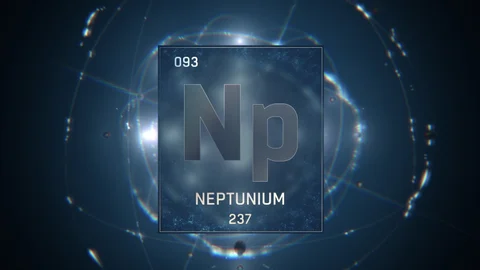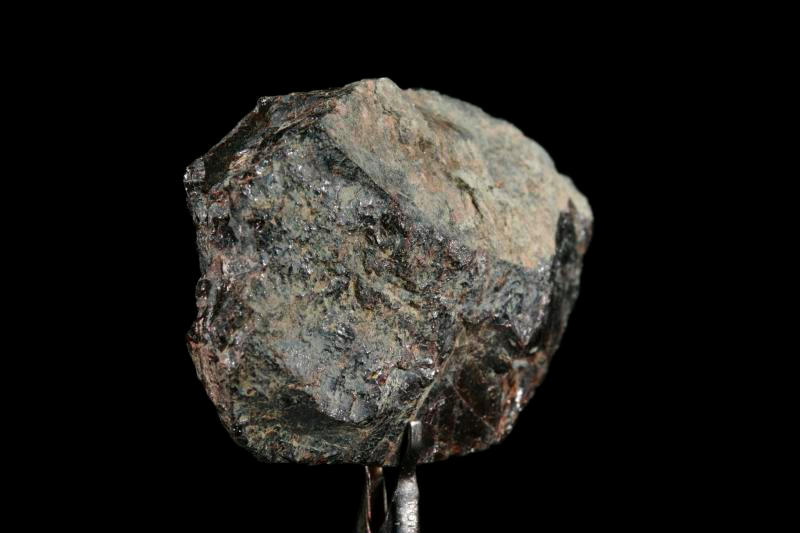Identity.
Neptunium, element number 93, stands out as a man-made marvel. Found
nowhere on Earth in its natural state, it was first conjured in a lab
by bombarding uranium with neutrons. This transuranic element, named
after the planet beyond Uranus, possesses a silvery sheen and hides a
potent secret: radioactivity. Neptunium's atoms are inherently
unstable, constantly shedding energy and transforming into other
elements over time. While fascinating for scientists, this instability
renders it hazardous, demanding careful handling and reminding us of
the power and complexities hidden within the atomic world.
Atomic Structure:
A neptunium atom has 93 electrons, arranged in the configuration [Rn]
5f4 6d1 7s2. This differs from the configuration expected by the
Aufbau principle in that one electron is in the 6d subshell instead of
being as expected in the 5f subshell. Further exploration revealed
neptunium's role in the nuclear fuel cycle. As uranium-238 absorbs
neutrons in reactors, it converts into plutonium-239, a fuel source.
But before becoming plutonium, uranium goes through an intermediate
stage: neptunium-239. This realization solidified neptunium's place in
the nuclear realm, albeit a short-lived one as it quickly decays into
plutonium.
History.
Neptunium's story unfolds in the heart of scientific discovery. In
1940, at the University of California, Berkeley, Edwin McMillan and
Philip Abelson conjured the element into existence. Bombarding uranium
with neutrons, they witnessed the birth of neptunium, the first
transuranic element ever created. Its name pays homage to its position
on the periodic table, following uranium just as Neptune follows
Uranus in the solar system.
Initially, scientists believed neptunium wasn't found naturally.
However, traces were later discovered in uranium ores, remnants of
ancient nuclear reactions within the Earth. While rare, these
findings painted a fascinating picture of neptunium's prehistoric
existence.
Neptunium's journey doesn't end there. Its unique properties hold
potential for future applications. Research explores its use in
medical imaging due to its ability to emit specific types of
radiation. Additionally, its radioactive decay chain offers
insights into stellar processes, helping us understand how stars
forge heavier elements. Though born in a lab, neptunium's story
extends far beyond its synthetic origins. It's a testament to
scientific innovation, a window into the Earth's hidden past, and
a key player in the nuclear world, holding the potential for
exciting future discoveries.
Usage.
Neptunium, a synthetic element born in the lab, boasts limited but
intriguing usage. While not directly fueling power, it acts as a key
player in creating plutonium-238 for spacecraft generators and
terrestrial beacons. Additionally, its ability to detect high-energy
neutrons makes it useful in nuclear safety monitoring and
non-destructive testing. Though research is ongoing, potential future
applications lie in medical imaging and nuclear waste management.
Remember, this radioactive element demands careful handling and isn't
safe for everyday use.
-
Precursor to Plutonium: While not directly used as fuel,
neptunium-237 plays a crucial role in producing plutonium-238, a
valuable isotope used in: Spacecraft Generators: Providing
reliable power on distant missions where sunlight is unavailable.
Terrestrial Beacons: Offering long-lasting power for remote
navigation and monitoring systems.
-
Neutron Detecion: Neptunium-237's unique properties allow
it to efficiently detect high-energy neutrons, making it useful
in: Nuclear Reactor Safety: Monitoring neutron levels for early
detection of potential issues. Non-Destructive Testing: Analyzing
materials for hidden cracks or anomalies without harming them.
-
Scientifice Research: Although limited currently, Neptunium
holds potential for future applications in: Medical Imaging:
Certain isotopes may offer possibilities for targeted imaging
techniques. Nuclear Waste Management: Understanding its decay
pathways helps design safe and reliable storage solutions.
-
Nuclear Fuel Cycle: Though not a primary fuel source
itself, neptunium-237 contributes to the overall efficiency of the
nuclear fuel cycle by: Breeding: Converting fertile uranium-238
into fissionable plutonium, potentially extending fuel resources.
Understanding Actinide Behavior: Research on neptunium helps
optimize fuel handling and waste management within reactors.
Some of the benefits of using Neptunium are:
-
Though not directly used as fuel, Neptunium-237 plays a crucial
role in producing Plutonium-238, a valuable isotope used in
spacecraft generators and terrestrial beacons, offering clean
energy solutions in remote locations where traditional forms are
impractical.
-
Neptunium-237's ability to detect high-energy neutrons finds
application in nuclear reactor safety monitoring, allowing for
early detection of potential issues and promoting safer operation.
It also holds potential for use in non-destructive testing,
helping identify structural flaws in materials without causing
damage.
-
Although still in the research stage, some Neptunium isotopes
might be useful in developing targeted medical imaging techniques
for specific diagnoses. Further studies are needed to determine
their viability and safety for such applications.
-
Understanding Neptunium's decay pathways and behavior contributes
to designing safer and more reliable storage solutions for nuclear
waste, particularly for transuranic elements with longer
half-lives. This knowledge helps minimize environmental risks
associated with spent nuclear fuel.
Sources.
While it might seem like something from outer space, Neptunium
actually has two sources: human ingenuity and Earth's hidden history.
Primarily, it's crafted in nuclear reactors as a byproduct of
uranium-238 absorbing neutrons. This nuclear alchemy births
Neptunium-239, which quickly decays into the most common isotope,
Neptunium-237. But wait, there's more! Tiny traces of Neptunium-237
and -239 also exist naturally in uranium ores, formed by ancient
nuclear reactions deep within the Earth. So, although it's mostly
man-made, Neptunium has a surprising connection to our planet's hidden
past.
Properties.
Radionactive : Neptunium is inherently unstable, meaning its
atoms constantly emit radiation and transform into other elements. Its
most stable isotope, Neptunium-237, boasts a half-life of over 2
million years, but others decay much faster. This radioactivity
necessitates careful handling and security measures.
Unique Neutron Interaction: Neptunium exhibits specific
reactions with neutrons. It efficiently detects high-energy neutrons,
making it valuable in monitoring nuclear reactor safety and performing
non-destructive testing on materials. Additionally, understanding its
decay chain offers insights into stellar processes and how stars forge
heavier elements.
Complex Metal Behavior: As a silvery metal, Neptunium exists in
multiple solid phases with varying crystal structures. These phases
influence its physical and chemical properties, including its
reactivity with other elements and its ability to form compounds.
Exploring these intricacies helps researchers predict its behavior in
different environments and optimize its potential applications.

